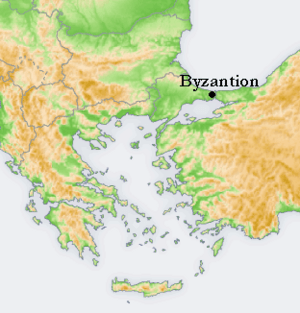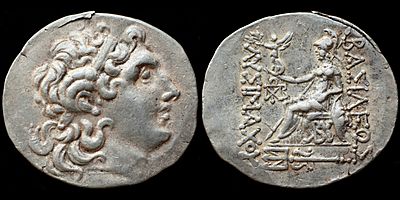Byzantium facts for kids
|
Byzantion
|
|

Location of Byzantion, corresponding to the modern-day Fatih district of İstanbul
|
|
| Alternative name | Byzantion (earlier Greek name), Nova Roma ("New Rome") |
|---|---|
| Location | Fatih, Istanbul Turkey |
| Region | Marmara Region |
| Coordinates | 41°00′55″N 28°59′05″E / 41.01528°N 28.98472°E |
| Type | Ancient city |
| Part of | |
| Area | 6 km2 (2.3 sq mi) enclosed within Constantinian Walls 14 km2 (5.4 sq mi) enclosed within Theodosian Walls |
| History | |
| Founded | 667 BC |
| Cultures |
|
Byzantium (Greek: Βυζάντιον) was an ancient Greek city. The name "Byzantium" is a Latinization of the original name Byzantion.
The city became the center of the Byzantine Empire, (the Greek-speaking Roman Empire of late Antiquity and the Middle Ages), but at that time it was already called Constantinople.
Contents
Etymology
The etymology of Byzantium is unknown. It has been suggested that the name is of Thracian origin. It may be derived from the Thracian personal name Byzas which means "he-goat". Ancient Greek legend refers to the Greek king Byzas, the leader of the Megarian colonists and founder of the city. The name Lygos for the city, which likely corresponds to an earlier Thracian settlement, is mentioned by Pliny the Elder in his Natural History.
Byzántios, plural Byzántioi (Ancient Greek: Βυζάντιος, Βυζάντιοι, Latin: Byzantius; adjective the same) referred to Byzantion's inhabitants, also used as an ethnonym for the people of the city and as a family name. In the Middle Ages, Byzántion was also a synecdoche for the eastern Roman Empire. (An ellipsis of Medieval Greek: Βυζάντιον κράτος, romanized: Byzántion krátos). Byzantinós (Medieval Greek: Βυζαντινός, Latin: Byzantinus) denoted an inhabitant of the empire. The Anglicization of Latin Byzantinus yielded "Byzantine", with 15th and 16th century forms including Byzantin, Bizantin(e), Bezantin(e), and Bysantin as well as Byzantian and Bizantian.
The name Byzantius and Byzantinus were applied from the 9th century to gold Byzantine coinage, reflected in the French besant (d'or), Italian bisante, and English besant, byzant, or bezant. The English usage, derived from Old French besan (pl. besanz), and relating to the coin, dates from the 12th century.
Later, the name Byzantium became common in the West to refer to the Eastern Roman Empire, whose capital was Constantinople. As a term for the east Roman state as a whole, Byzantium was introduced by the historian Hieronymus Wolf only in 1555, a century after the last remnants of the empire, whose inhabitants continued to refer to their polity as the Roman Empire (Medieval Greek: Βασιλεία τῶν Ῥωμαίων, romanized: Basileía tōn Rhōmaíōn, lit. 'empire of the Romans'), had ceased to exist.
Other places were historically known as Byzántion (Βυζάντιον) – a city in Libya mentioned by Stephanus of Byzantium and another on the western coast of India referred to by the Periplus of the Erythraean Sea; in both cases the names were probably adaptations of names in local languages. Faustus of Byzantium was from a city of that name in Cilicia.
History
Legend
The origins of Byzantium are not clear. There is only a legend. It tells that a certain Byzas from Megara (a town near Athens), founded Byzantium, when he sailed northeast across the Aegean Sea. He had asked the Oracle at Delphi where he should found his new city. The Oracle told him to find it "opposite the blind." At the time, he did not know what this meant. But when he came upon the Bosporus he realized what it meant: on the Asiatic shore was a Greek city, Chalcedon. It was they who must have been blind because they had not seen that obviously superior land was just a half mile away on the other side of the Bosporus. Byzas founded his city here in this "superior" land and named it Byzantion after himself.
History before Constantine I
 |
|
| O: Head of Alexander the Great with Amun's horns. | R: Seated Athena holding Nike with wreath, ΒΑΣΙΛΕΩΣ / ΛΥΣΙΜΑΧΟΥ; monogram (ΠΩΛΥΒ) to left; ΒΥ below throne; trident in exergue |
| Silver tetradrachm struck in Byzantion c. 150–100 BC. Byzantion struck coins in the name of Lysimachus nearly 200 years after his death. | |
Byzantion was mainly a trading city due to its strategic location at the Black Sea's only entrance. Byzantion later conquered Chalcedon, across the Bosporus.
When it fought with Pescennius Niger against the victorious Septimius Severus, the city was besieged by Roman forces and suffered extensive damage in 196 AD. Byzantium was rebuilt by Septimius Severus, when he had become emperor, and quickly regained its earlier prosperity.
Center of the Eastern Roman Empire
When Roman Emperor Constantine I decided to move his capital to the Eastern part of the Roman Empire he chose the place of Byzantion because of its strategical value. He refounded it, in 330 AD, as Nova Roma. After his death the city was called Constantinople ('city of Constantine'). It remained the capital of the Eastern Roman Empire, which was later called the Byzantine Empire by historians.
Emblem
By the late Hellenistic or early Roman period (1st century BC), the star and crescent motif was associated to some degree with Byzantium; even though it became more widely used as the royal emblem of Mithradates VI Eupator (who for a time incorporated the city into his empire).
Some Byzantine coins of the 1st century BC and later show the head of Artemis with bow and quiver, and feature a crescent with what appears to be an eight-rayed star on the reverse. According to accounts which vary in some of the details, in 340 BC the Byzantines and their allies the Athenians were under siege by the troops of Philip of Macedon. On a particularly dark and wet night Philip attempted a surprise attack but was thwarted by the appearance of a bright light in the sky. This light is occasionally described by subsequent interpreters as a meteor, sometimes as the moon, and some accounts also mention the barking of dogs. However, the original accounts mention only a bright light in the sky, without specifying the moon. To commemorate the event the Byzantines erected a statue of Hecate lampadephoros (light-bearer or bringer). This story survived in the works of Hesychius of Miletus, who in all probability lived in the time of Justinian I. His works survive only in fragments preserved in Photius and the tenth century lexicographer Suidas. The tale is also related by Stephanus of Byzantium, and Eustathius.
Devotion to Hecate was especially favored by the Byzantines for her aid in having protected them from the incursions of Philip of Macedon. Her symbols were the crescent and star, and the walls of her city were her provenance.
It is unclear precisely how the symbol Hecate/Artemis, one of many goddesses would have been transferred to the city itself, but it seems likely to have been an effect of being credited with the intervention against Philip and the subsequent honors. This was a common process in ancient Greece, as in Athens where the city was named after Athena in honor of such an intervention in time of war.
Cities in the Roman Empire often continued to issue their own coinage. "Of the many themes that were used on local coinage, celestial and astral symbols often appeared, mostly stars or crescent moons." The wide variety of these issues, and the varying explanations for the significance of the star and crescent on Roman coinage precludes their discussion here. It is, however, apparent that by the time of the Romans, coins featuring a star or crescent in some combination were not at all rare.
People
- Homerus, tragedian, lived in the early 3rd century BC
- Philo, engineer, lived c. 280 BC–c. 220 BC
- Epigenes of Byzantium, astrologer, lived in the 3rd–2nd century BC
- Aristophanes of Byzantium, a scholar who flourished in Alexandria, 3rd–2nd century BC
- Myro, a Hellenistic female poet
See also
 In Spanish: Bizancio para niños
In Spanish: Bizancio para niños

